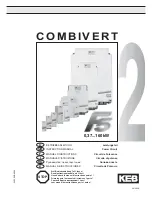
5.9 n: Special Adjustments
5.9
n: Special Adjustments
These parameters handle a variety of specialized adjustments and functions, including AFR Control, resistance between
motor lines, PM motor control functions, and current detection adjustments.
♦ n2: Speed Feedback Detection Control (AFR) Tuning
These parameters are used to achieve speed stability when a load is suddenly applied or removed.
N ote: Properly set all m otor param eters or perform Auto-Tuning before making changes to the A FR parameters.
■ n2-01: Speed Feedback Detection Control (AFR) Gain
Sets the internal speed feedback detection control gain in the AFR.
No.
Name
Setting Range
Default
n2-01
Speed Feedback Detection Control (AFR) Gain
0.00 to 10.00
1.00
Although this parameter rarely needs to be changed, it may require adjustment in the following situations:
• If hunting occurs, increase the setting value in steps of 0.05 while checking the response.
• If response is low, decrease the setting value in steps o f 0.05 while checking the response.
■ n2-02, n2-03: Speed Feedback Detection Control (AFR) Time Constant 1, 2
Parameter n2-02 sets the time constant normally used by AFR.
Parameter n2-03 sets the time constant during regenerative operation.
No.
Name
Setting Range
Default
n2-02
Speed Feedback Detection Control (AFR) Time Constant 1
0 to 2000 ms
50 ms
n2-03
Speed Feedback Detection Control (AFR) Time Constant 2
0 to 2000 ms
750 ms
Note: Setting param eter n2-02 higher than n2-03 will trigger an oPE08 error.
Although these parameters rarely need to be changed, they may require adjustment in the following situations:
• If hunting occurs, increase n2-02. If response is low, decrease it.
• Increase n2-03 if overvoltage occurs with high inertia loads at the end o f acceleration or with sudden load changes.
• If setting n2-02 to a higher value, also increase C4-02 (Torque Compensation Delay Time Constant 1) proportionally.
♦ n5: Inertia Compensation
Enabling Inertia Compensation improves the responsiveness o f the drive to speed reference changes in applications
where a high speed control proportional gain setting (C5-01, C5-03, C5-13) would lead to problems with overshoot,
undershoot, or oscillation.
Figure 5.41
gives an example o f overshoot reduction by Inertia Compensation. Parameters
related to this function and the function principle are illustrated in
Figure 5.42.
Inertia Compensation can only be used in
Closed Loop Vector Control for induction or PM motors (A1-02 = 3 or 7).
N ote: Prior to using Feed Forw ard, always perform Auto-Tuning or set the correct motor data manually. Also perform A SR A uto
Tuning to set the speed loop gain (C 5-01, C5-03, C 5-13), or adjust it manually. Fine-tune the other speed control loop parameters
(C 5 -D D ) if required.
Time (s)
Time (s)
Conventional Speed Control
Inertia Compensation Control
F ig u r e 5.41 O v e r s h o o t S u p p r e s s i o n b y In e r tia C o m p e n s a t io n
204
YASKAWA ELECTRIC SIEP C710616 33D YASKAWA AC Drive L1000A Technical Manual
















































